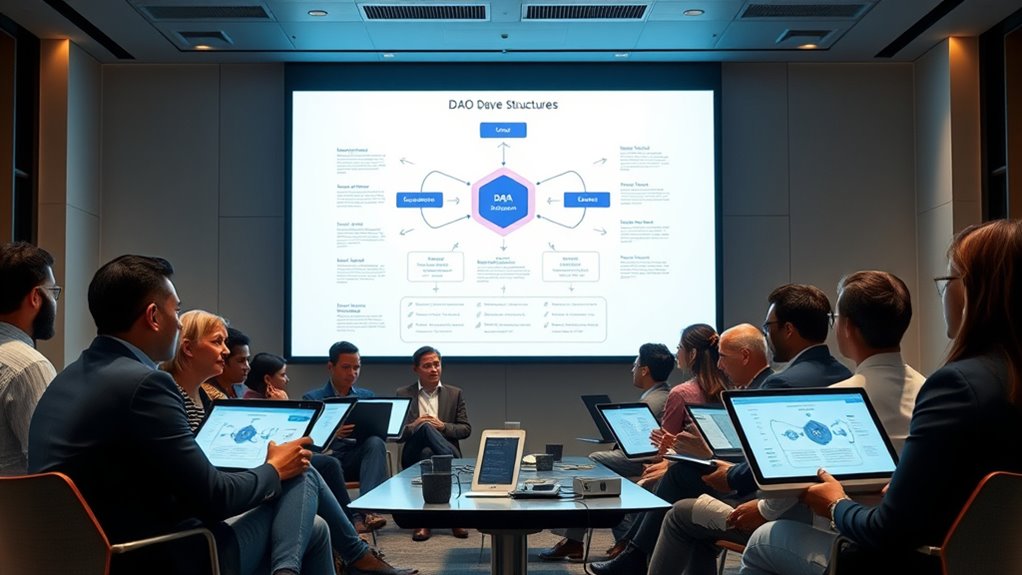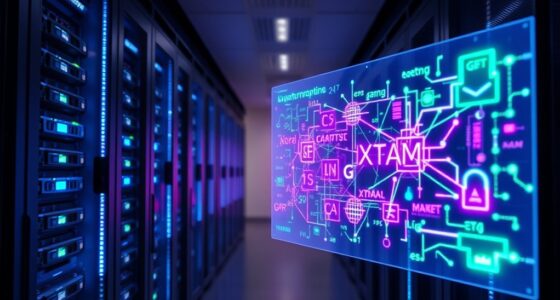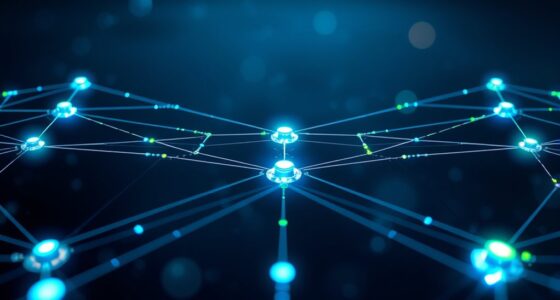Early DAO governance models show that combining token voting with reputation systems helps balance influence and promote active participation. Token voting offers scalability but risks centralization, while reputation systems foster trust and merit. Many experiments reveal that ongoing refinement and transparency are key to fair decision-making. If you explore these lessons further, you’ll discover how these approaches can be adapted to create more resilient and inclusive decentralized organizations.
Key Takeaways
- Combining token voting with reputation systems balances influence and promotes active, merit-based participation.
- Quorum thresholds prevent small groups from dominating decision-making in token-based voting.
- Reputation systems encourage trust and ongoing engagement but require careful design to prevent gaming.
- Early DAO experiments highlight the importance of transparent, adaptable governance structures.
- No one-size-fits-all model; continuous refinement and context-specific adjustments are essential for effective governance.

Have you ever wondered how decentralized organizations make decisions without traditional management structures? In the world of DAOs, decision-making relies heavily on mechanisms like token voting and reputation systems. Instead of a CEO or board, members participate directly in shaping the organization’s future. Token voting is one of the most common methods. When you hold tokens in a DAO, your voting power usually correlates with the number of tokens you possess. This means that if you own a significant amount, your voice carries more weight in proposals and governance decisions. While this approach incentivizes token ownership, it can also create centralization risks, as the most invested members could dominate decisions. To address this, some DAOs implement quorum thresholds or weighted voting to prevent a small group from controlling outcomes.
Token voting grants more influence to large token holders, risking centralization but enabling scalable decision-making.
Reputation systems add another layer to governance, emphasizing trust and participation rather than mere token holdings. In these systems, your influence depends on your history of positive contributions, engagement, and consistent behavior within the community. For example, if you regularly submit valuable proposals, review others’ ideas carefully, or help onboard new members, your reputation score increases. This, in turn, grants you more say in future decisions without necessarily needing to own a large number of tokens. Reputation systems aim to foster a more meritocratic environment, encouraging active and constructive involvement. They help mitigate some of the pitfalls of token voting, such as wealth concentration and passive ownership.
Early experiments with these models reveal both strengths and challenges. Token voting enables swift, scalable decision-making, giving all token holders a say. However, it often favors those with significant holdings, risking plutocratic control. Reputation systems, on the other hand, promote active participation, but they can be complex to design and maintain, with issues like gaming the system or subjective scoring. Successful DAOs often combine these approaches, using token voting for major decisions and reputation metrics for community engagement or smaller proposals. This hybrid model balances influence and encourages ongoing participation.
As you observe these experiments, it becomes clear that no single governance model fits all DAOs. Each organization adapts mechanisms like token voting and reputation systems to its unique goals and community dynamics. Learning from these early tests helps you understand that effective decentralized decision-making requires continuous refinement, transparency, and balancing incentives. These lessons show that while blockchain-based governance offers exciting possibilities, it also demands careful design to guarantee fairness, resilience, and sustained engagement. Additionally, ongoing research and innovations in decentralized governance are essential to improving these models and ensuring they serve diverse organizational needs effectively.
Frequently Asked Questions
How Do DAOS Resolve Disputes Among Members?
When disputes arise among DAO members, you rely on smart contracts to enforce rules and procedures automatically. These contracts often include mechanisms like voting or stakeholder consensus to resolve disagreements fairly. You might also use dispute resolution protocols built into the DAO’s framework, encouraging open discussion and consensus-building. This approach helps guarantee decisions are transparent, reducing conflicts and maintaining trust within the community.
What Are the Legal Implications of DAO Governance?
You should consider that DAO governance has complex legal implications, especially around legal compliance and jurisdictional challenges. Since DAOs operate across borders, they often face uncertainties about how local laws apply. This can impact your ability to enforce rules or resolve disputes. You need to stay informed about evolving regulations, as legal frameworks may differ substantially, affecting your DAO’s legitimacy and operations worldwide.
How Do Voting Mechanisms Impact Decision Quality?
You see, voting mechanisms directly impact decision quality by influencing voting transparency and decision bias. When voting is transparent, you can better trust the process and detect any manipulation. However, decision bias might skew results if certain voices dominate or if voters are influenced by emotions rather than facts. By designing clear, transparent voting processes, you guarantee fairer decisions and reduce biases, ultimately improving the overall quality of governance.
What Role Does Token Distribution Play in Governance?
Imagine you hold a large share of governance tokens, giving you significant influence over decisions. Token allocation directly affects governance since those with more tokens often have more voting power, potentially skewing decision-making. Proper distribution of governance tokens guarantees fairness and decentralization. For example, evenly spread token distribution prevents power concentration, encouraging diverse participation and better decision quality in your DAO.
How Can DAOS Adapt to Rapid Technological Changes?
To adapt to rapid technological changes, you should prioritize technology adaptation and embrace innovation strategies. Stay informed about emerging trends, experiment with new tools, and foster a culture of continuous learning. By being flexible and proactive, you can guarantee your DAO remains relevant and resilient. Regularly review your governance processes, incorporate feedback, and leverage innovative solutions to stay ahead in the fast-evolving blockchain landscape.
Conclusion
As you explore DAO governance models, remember that every experiment is like tending a delicate garden—some seeds flourish quickly, while others need patience and care. By observing these early attempts, you can better understand how to nurture a balanced, resilient ecosystem. Embrace the gentle lessons they offer, allowing your vision to grow steadily. With time and attention, your governance approach can blossom into a thriving, harmonious community.









